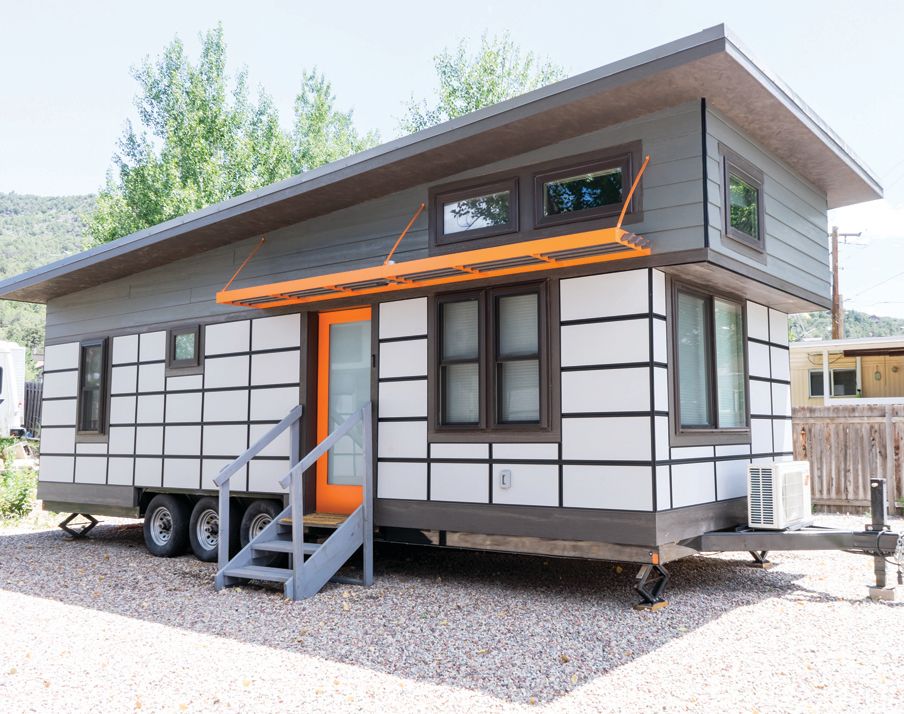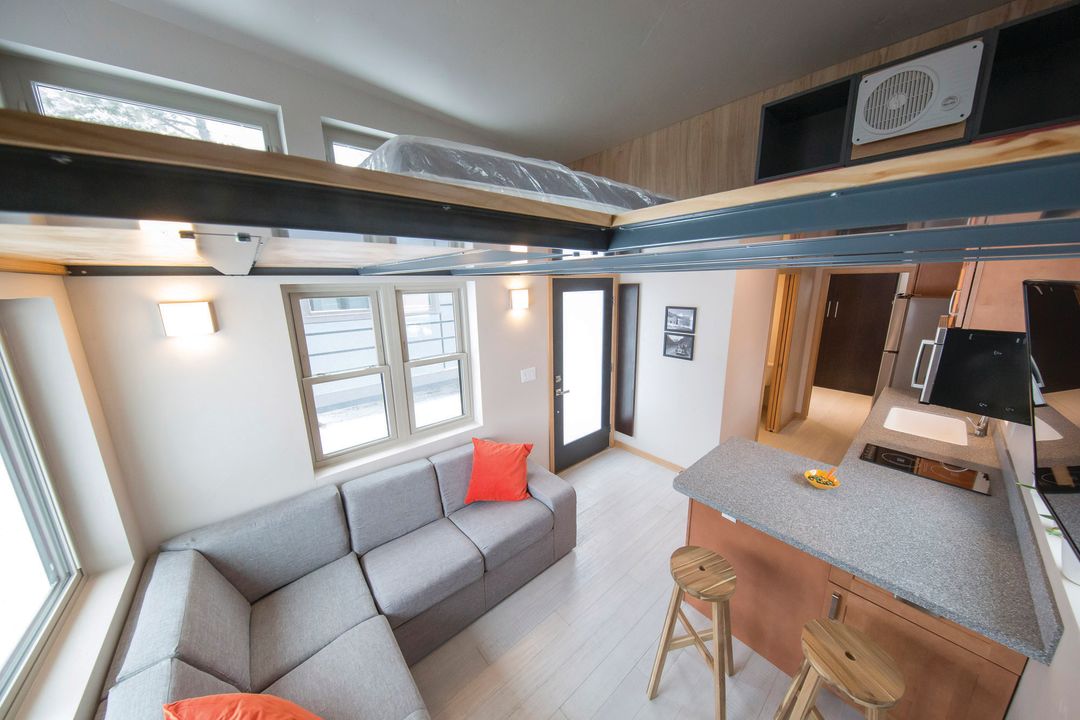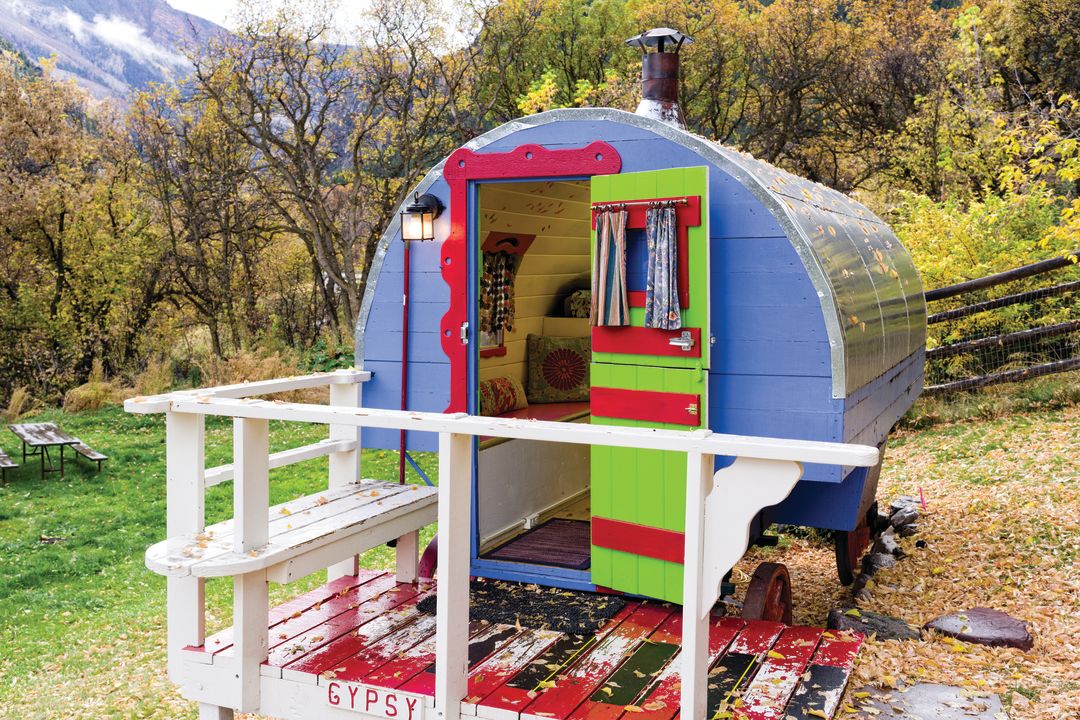Are Tiny Homes the Answer to the Roaring Fork Valley's Housing Crisis?

The exterior of one of Aspen Skiing Company's new units, which will house seasonal employees.
Image: Craig Turpin
In an area where land prices are among the most expensive in the country and square footage for residential housing can actually be bought and sold, tiny homes will likely never proliferate. Nonetheless, in the rarefied air of the Roaring Fork Valley real estate market, petite dwelling options have started to crop up in the quiver of potential solutions to the local affordable housing crunch.
Aspen Skiing Company, the valley’s largest employer and the one likely housing the most employees, successfully experimented with six diminutive abodes this past winter at the Aspen Basalt Campground, the midvalley RV park it bought in 2008 for seasonal employee housing. The approximately 500-square-foot “trailer coaches,” complete with license plates, wheels, and lights (they’re technically RVs, so are an allowed use in the campground), worked out so well that SkiCo ordered 34 more—to be ready by Labor Day—from Sprout Tiny Homes in southeast Colorado.
“We have a huge demand and a shortage of housing, especially for seasonal employees, so we’ve been forced to take action—and this project is the fastest way we can act,” says Philip Jeffreys, SkiCo’s affordable housing project manager.
Jeffreys pointed out that it takes just 10 weeks to build the trailer coaches, at which point they’re rolled onto the site and plugged in—ready to live in. And if at some point down the road the company’s needs change, “we could just drive them off. They can be gone in a day,” he adds.
Meanwhile, downvalley in Garfield County, county commissioners in March approved land-use and building code changes that pave the way for tiny homes. A 20-foot-by-20-foot minimum home-size requirement, implemented in the 1970s to prevent single-wide mobile homes, was eliminated, as was a piece of the building code that prohibited ladders from accessing lofts, which tiny homes often use for sleeping spaces.
“Changing the code was inspired by the tiny-home movement—we’ve had inquiries from people wanting to do tiny-home communities,” says Garfield County senior planner Dave Pesnichak. “But the amendments were to expand the diversity of housing in the county.”
Pesnichak explains that given the valley’s high land prices, some people who buy lots can’t afford to build their dream home right away. The code changes allow them to build or bring in something small—with a foundation—in the meantime. “The idea wasn’t that this was a silver bullet for affordable housing, by any means, but it was one way we could help people out,” he says.
Trendy as they may now be, tiny homes historically hewed more to the norm. Notes Garfield County building official Andy Schwaller, “In the 1930s, many houses were 16 foot by 16 foot, around 250 square feet. Nobody called them tiny homes—that’s what people lived in. And if you go to cities, you’ll find efficiency colonies. So the concept has been around for a long time, it’s just a different iteration now.”

Inside one of SkiCo's new units from Sprout Tiny Homes.
Image: Hal Williams
Meanwhile, on the upper end of the valley, nothing in Aspen’s or Pitkin County’s codes precludes smaller residences on foundations, while those on wheels would be allowed in mobile home parks. They’d be more likely to run into barriers in subdivisions that require homes to be a minimum size—as does the Aspen Pitkin County Housing Authority (APCHA), which provides the lion’s share of the upper valley’s affordable housing. “There’s a strong interest in tiny homes from the development side,” says Mike Kosdrosky, APCHA’s executive director, who cites a recent conversation with a “serious legitimate respected developer” about a tiny-home project. But even if APCHA’s minimum home size were eliminated, “the big question is where do you get the land,” he notes.
Pitkin County’s Community Development department has also fielded some inquiries from people interested in tiny homes, which assistant director Suzanne Wolff points out is notable because “we live in such a unique world that it’s rare that anyone wants to do something small around here.” But while there are few bureaucratic barriers to tiny homes in Pitkin County, “there’s nothing to encourage them at this point,” says Wolff, particularly the free market. “I don’t think the land values are going to support it on any kind of scale.”
Jeff Nalley, owner of OutWest Tiny Homes in New Castle, believes the valley “could curb its housing shortages and high rent issues with tiny homes.” He envisions a few tiny-home subdivisions and allowing tiny-home rentals on private land. Yet he hasn’t seen an uptick in interest since Garfield County loosened its restrictions. Why? Basic American nature, he thinks.
“The excitement and interest is there—there just doesn’t seem to be a large serious buyer base,” says Nalley. “I think most like the idea, but when they look at spending $25,000-plus for a couple hundred square feet, it’s not too hard to realize that for four times the cost you can get 10 times the house.”

Image: Courtesy: Avalanche Ranch
Try a Tiny House on for Size
Avalanche Ranch, between Carbondale and Redstone, includes among its nightly cabin rentals the 100-square-foot Hilltop cabin ($125; two-night minimum), which contains a full bed, microwave, and mini-fridge in its snug interior. The ranch also offers three restored shepherd’s wagons ($85); these compact one-time homes on wheels—outfitted with a built-in bed, seating, and propane heaters—were historically used by herders on the move while tending to their sheep. Apparently dating back to 16th-century Britain, they could be considered the original tiny house. avalancheranch.com













































